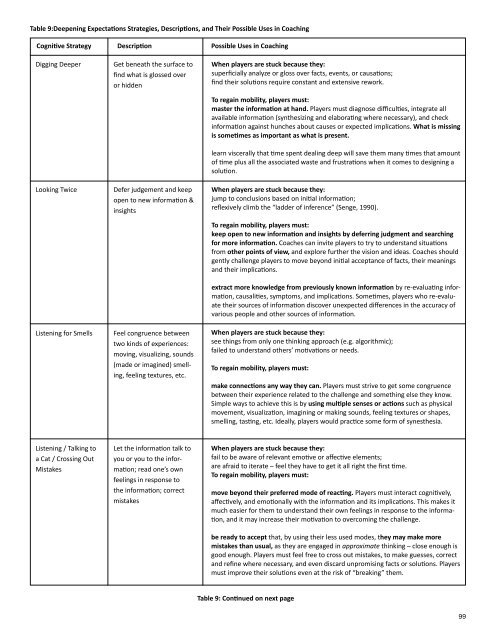Torrance Journal for Applied Creativity
TorranceJournal_V1
TorranceJournal_V1
You also want an ePaper? Increase the reach of your titles
YUMPU automatically turns print PDFs into web optimized ePapers that Google loves.
Table 9:Deepening Expectations Strategies, Descriptions, and Their Possible Uses in Coaching<br />
Cognitive Strategy Description Possible Uses in Coaching<br />
Digging Deeper<br />
Looking Twice<br />
Listening <strong>for</strong> Smells<br />
Get beneath the surface to<br />
find what is glossed over<br />
or hidden<br />
Defer judgement and keep<br />
open to new in<strong>for</strong>mation &<br />
insights<br />
Feel congruence between<br />
two kinds of experiences:<br />
moving, visualizing, sounds<br />
(made or imagined) smelling,<br />
feeling textures, etc.<br />
When players are stuck because they:<br />
superficially analyze or gloss over facts, events, or causations;<br />
find their solutions require constant and extensive rework.<br />
To regain mobility, players must:<br />
master the in<strong>for</strong>mation at hand. Players must diagnose difficulties, integrate all<br />
available in<strong>for</strong>mation (synthesizing and elaborating where necessary), and check<br />
in<strong>for</strong>mation against hunches about causes or expected implications. What is missing<br />
is sometimes as important as what is present.<br />
learn viscerally that time spent dealing deep will save them many times that amount<br />
of time plus all the associated waste and frustrations when it comes to designing a<br />
solution.<br />
When players are stuck because they:<br />
jump to conclusions based on initial in<strong>for</strong>mation;<br />
reflexively climb the “ladder of inference” (Senge, 1990).<br />
To regain mobility, players must:<br />
keep open to new in<strong>for</strong>mation and insights by deferring judgment and searching<br />
<strong>for</strong> more in<strong>for</strong>mation. Coaches can invite players to try to understand situations<br />
from other points of view, and explore further the vision and ideas. Coaches should<br />
gently challenge players to move beyond initial acceptance of facts, their meanings<br />
and their implications.<br />
extract more knowledge from previously known in<strong>for</strong>mation by re-evaluating in<strong>for</strong>mation,<br />
causalities, symptoms, and implications. Sometimes, players who re-evaluate<br />
their sources of in<strong>for</strong>mation discover unexpected differences in the accuracy of<br />
various people and other sources of in<strong>for</strong>mation.<br />
When players are stuck because they:<br />
see things from only one thinking approach (e.g. algorithmic);<br />
failed to understand others’ motivations or needs.<br />
To regain mobility, players must:<br />
make connections any way they can. Players must strive to get some congruence<br />
between their experience related to the challenge and something else they know.<br />
Simple ways to achieve this is by using multiple senses or actions such as physical<br />
movement, visualization, imagining or making sounds, feeling textures or shapes,<br />
smelling, tasting, etc. Ideally, players would practice some <strong>for</strong>m of synesthesia.<br />
Listening / Talking to<br />
a Cat / Crossing Out<br />
Mistakes<br />
Let the in<strong>for</strong>mation talk to<br />
you or you to the in<strong>for</strong>mation;<br />
read one’s own<br />
feelings in response to<br />
the in<strong>for</strong>mation; correct<br />
mistakes<br />
When players are stuck because they:<br />
fail to be aware of relevant emotive or affective elements;<br />
are afraid to iterate – feel they have to get it all right the first time.<br />
To regain mobility, players must:<br />
move beyond their preferred mode of reacting. Players must interact cognitively,<br />
affectively, and emotionally with the in<strong>for</strong>mation and its implications. This makes it<br />
much easier <strong>for</strong> them to understand their own feelings in response to the in<strong>for</strong>mation,<br />
and it may increase their motivation to overcoming the challenge.<br />
be ready to accept that, by using their less used modes, they may make more<br />
mistakes than usual, as they are engaged in approximate thinking – close enough is<br />
good enough. Players must feel free to cross out mistakes, to make guesses, correct<br />
and refine where necessary, and even discard unpromising facts or solutions. Players<br />
must improve their solutions even at the risk of “breaking” them.<br />
Table 9: Continued on next page<br />
99


